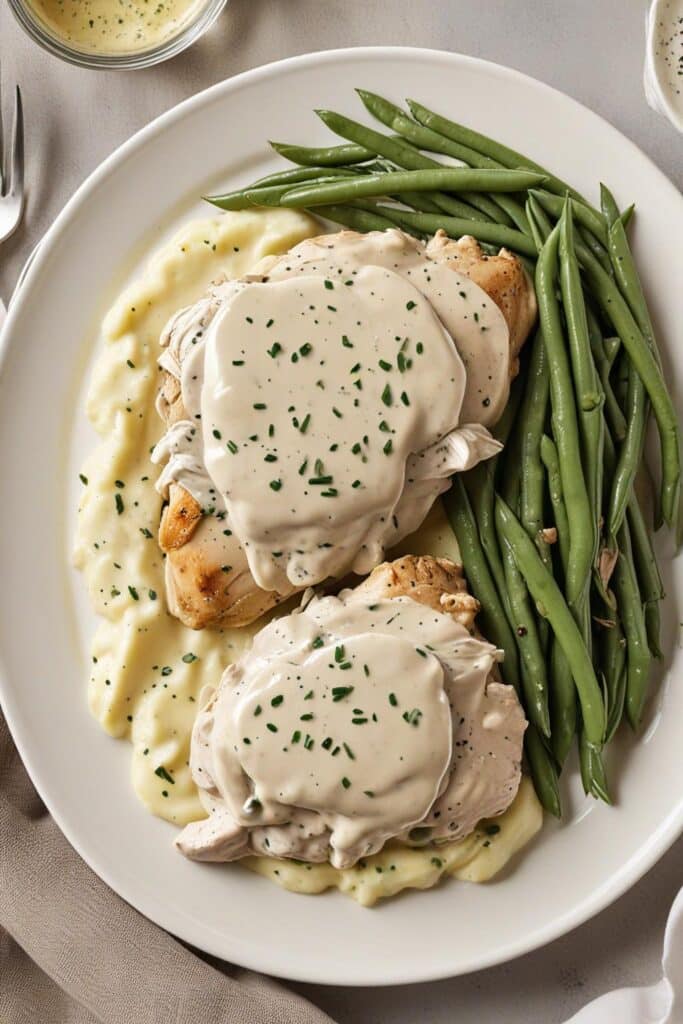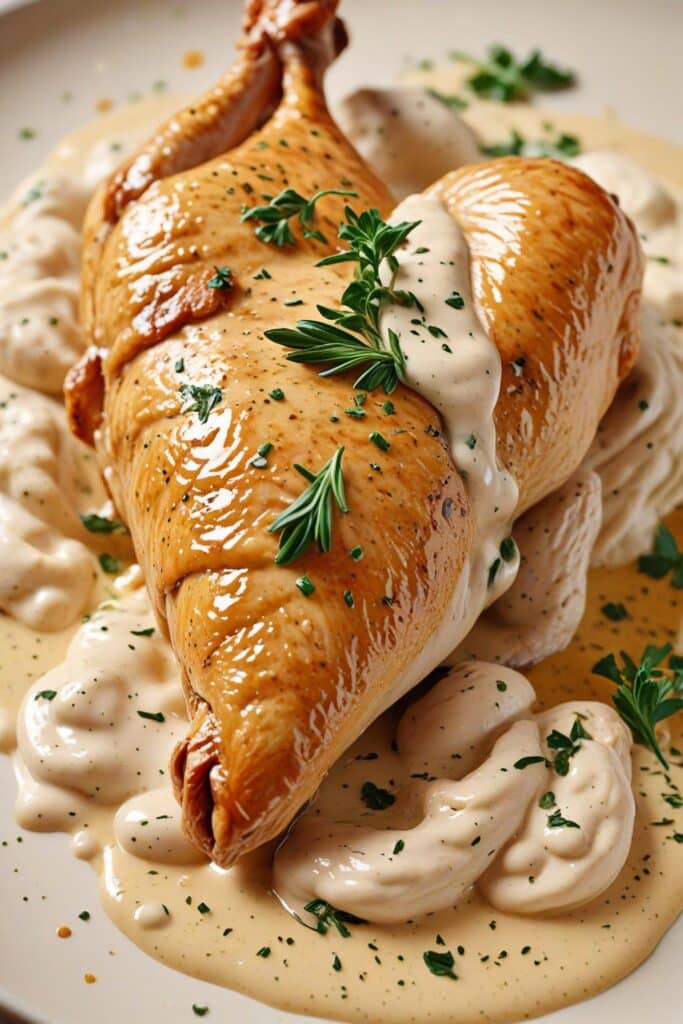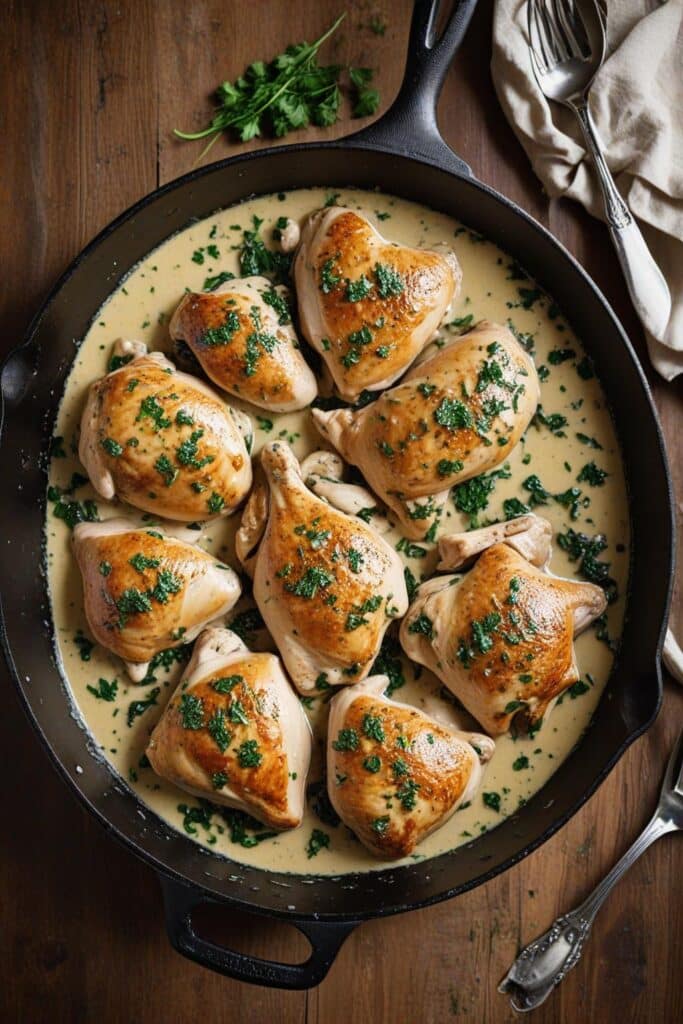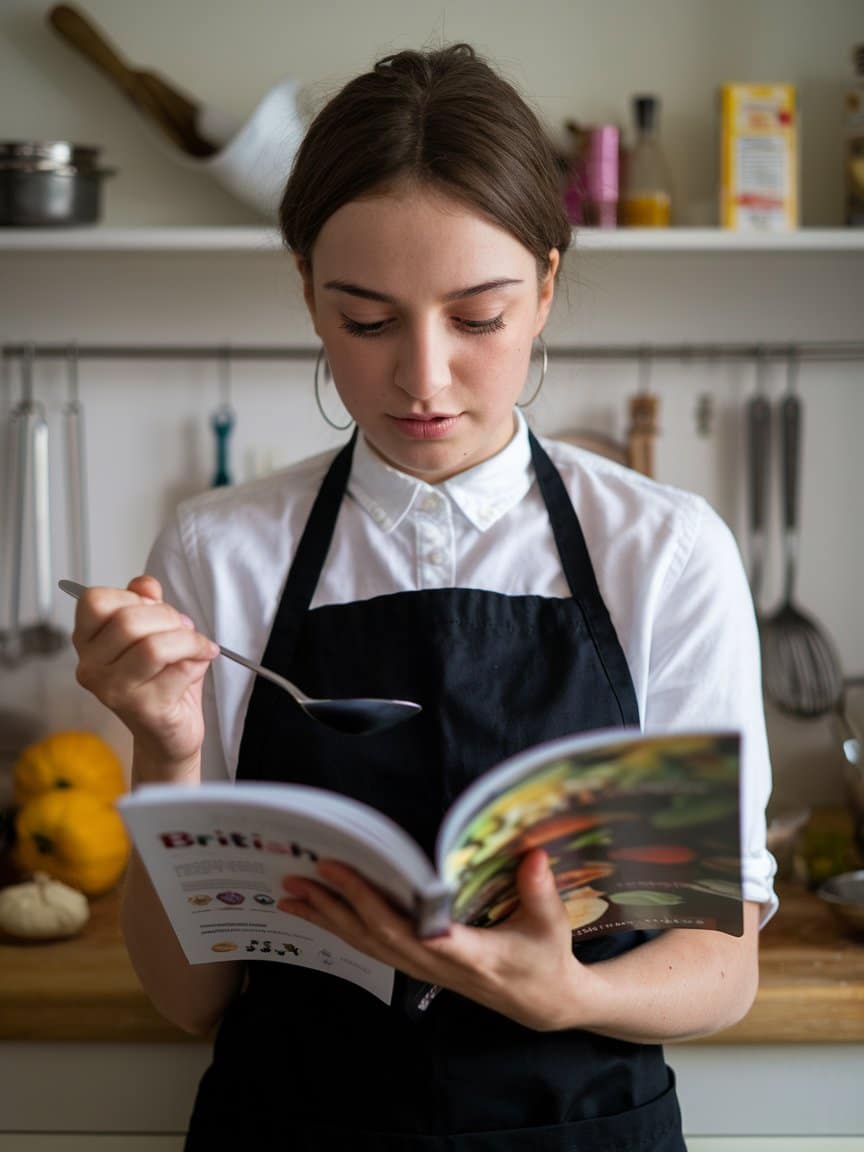The first time I served creamy ranch chicken at my restaurant’s staff meal, the kitchen fell silent. It wasn’t the fancy Michelin-inspired dishes that got our crew excited—it was this humble, creamy masterpiece that had everyone scraping their plates. I’ve spent nearly 20 years in professional kitchens, and I’m still amazed at how the simplest dishes can create the most profound food memories.
Creamy ranch chicken sits at that perfect crossroads of comfort and sophistication. It’s the dish I turn to when training new line cooks on balancing flavors and textures. The marriage of tangy ranch seasoning with velvety cream creates something that’s simultaniously familiar yet elevated. Let me walk you through this cornerstone recipe that’s been a secret weapon in my culinary arsenal for years.
Ingredients & Substitutions
For the Chicken Base:
- 2 pounds boneless, skinless chicken breasts (about 4 medium breasts)
- 2 tablespoons olive oil
- 1 tablespoon unsalted butter
- 1 medium yellow onion, finely diced
- 4 garlic cloves, minced
- 1/2 cup dry white wine (Sauvignon Blanc or Pinot Grigio work beautifully)
- 1 cup chicken stock (preferably homemade, but low-sodium store-bought works)
For the Creamy Ranch Element:
- 1 1/2 cups heavy cream
- 3 tablespoons homemade ranch seasoning (recipe below)
- 8 oz cream cheese, softened and cubed
- 1/2 cup freshly grated Parmesan cheese
- 1 tablespoon fresh lemon juice
For Homemade Ranch Seasoning:
- 2 tablespoons dried parsley
- 1 1/2 tablespoons dried dill
- 2 teaspoons garlic powder
- 2 teaspoons onion powder
- 1 1/2 teaspoons dried chives
- 1 teaspoon sea salt
- 1/2 teaspoon freshly ground black pepper
- 1/2 teaspoon dried thyme
For Garnish:
- 2 tablespoons fresh chives, finely chopped
- Fresh dill sprigs
- Cracked black pepper
When it comes to substitutions, don’t skimp on the cream—half-and-half simply doesn’t create the same lushious mouthfeel. For dairy-free folks, full-fat coconut cream mixed with a tablespoon of nutritional yeast approximates the richness, though the flavor profile shifts slightly toward the tropical.
Boneless thighs can replace breasts if you prefer darker meat; they actually bring more moisture and forgiveness to the cooking process. The key is adjusting cooking time—thighs need about 2-3 minutes longer than breasts.
For the wine component, chicken stock with a tablespoon of white wine vinegar makes a decent alchohol-free alternative. The acidity is critical for cutting through the richness of the cream.
Step-by-Step Instructions

Preparing the Chicken
- Pat chicken breasts completely dry with paper towels. This step is non-negotiable—moisture is the enemy of proper browning. Season generously with salt and pepper on both sides.
- Heat olive oil in a large, heavy-bottomed skillet (preferably cast iron) over medium-high heat until shimmering but not smoking. Lay chicken breasts in carefully, presentation side down first. Resist the urge to move them for at least 4 minutes.
- Once golden brown on the first side, flip and cook for another 3-4 minutes. The chicken should not be completely cooked through at this point—we’re aiming for about 80% doneness as it’ll finish cooking in the sauce. Transfer to a clean plate and tent loosely with foil.
Building the Flavor Base
- Return the skillet to medium heat and add butter. Once melted, add diced onions with a pinch of salt. Cook for 4-5 minutes until translucent and beginning to caramelize at the edges. Many cooks rush this step—don’t. Those caramelized bits are flavor gold.
- Add minced garlic and cook for 30 seconds untill fragrant. Be watchful here—garlic burns in an instant and will ruin your entire sauce with bitterness.
- Pour in the white wine and use a wooden spoon to scrape up the fond (those delicious browned bits) from the bottom of the pan. Let the wine reduce by half, about 2-3 minutes. This deglazing step is where so much complexity develops.
Creating the Creamy Ranch Sauce
- Pour in the chicken stock and bring to a gentle simmer. Add the ranch seasoning and whisk to incorporate completely.
- Reduce heat to medium-low and slowly pour in the heavy cream while whisking constantly. This gradual introduction prevents the cream from breaking or curdling.
- Add cream cheese in small chunks, allowing each addition to melt before adding the next. The sauce should be velvety and smooth, with no visible lumps. If you see any forming, a quick blitz with an immersion blender fixes the issue immediately.
- Fold in the grated Parmesan and stir until completely melted. Add lemon juice and stir—this brightens the entire dish and balances the richness. A common misstake is omitting acid in creamy dishes; don’t skip this.
Finishing the Dish
- Slice the partially cooked chicken into 1/2-inch thick pieces against the grain. Return the chicken and any accumulated juices to the pan, nestling the pieces into the sauce.
- Simmer gently for 5-7 minutes until chicken registers 165°F (74°C) on an instant-read thermometer and the sauce has thickened slightly. If the sauce becomes too thick, thin with a splash of warm chicken stock.
- Off heat, let the dish rest for 3-5 minutes. This resting period allows the flavors to meld and the sauce to reach the perfect consistency. Top with fresh chives and dill sprigs just before serving.
The most common error I see with this dish is rushing the final simmer. Low and slow is the approach for the creamiest result. High heat will break your sauce, leaving you with a greasy, separated mess.
For a smokier variation, substitute 1/2 teaspoon of smoked paprika for the thyme in the ranch seasoning. For extra vegetable content, adding 2 cups of baby spinach during the final simmer transforms this into a complete one-pan meal.
Cooking Techniques & Science
The success of this dish hinges on understanding two fundamental culinary principles: the Maillard reaction and emulsification. When searing the chicken initially, we’re activating the Maillard reaction—a chemical reaction between amino acids and reducing sugars that creates hundreds of new flavor compounds. This is why that golden-brown crust is so important; it’s not just visual appeal but flavor development.

The creamy sauce relies on proper emulsification—the stable suspension of fat molecules in liquid. The lecithin in cream cheese acts as a natural emulsifier, helping bind the fats from cream and butter with the water-based components. This explains why the sauce maintains its silky texture without breaking.
Temperature control remains critical throughout. Too high heat when adding dairy components will cause proteins to coagulate unevenly, resulting in graininess. That’s why we reduce heat before adding cream and add cream cheese in stages.
The foundational technique of “sweating” the onions provides aromatic compounds that serve as the flavor backbone. These compounds are fat-soluble, which means they infuse into the oils and butter, then disperse throughout the creamy matrix. This layering of fat-soluble flavors is what gives the dish its characteristic depth.
For equipment, I strongly recommend a 12-inch cast-iron skillet for this recipe. The even heat distribution and excellent heat retention make it ideal for both the searing phase and the gentle simmering needed for the sauce. If cast iron isn’t available, a heavy-bottomed stainless steel pan works, though you’ll need to monitor heat more carefully.
Serving & Pairing Suggestions
Creamy ranch chicken has a rich, robust presence that calls for thoughtful accompaniments. I prefer serving it over pappardelle pasta—those wide ribbons catch the sauce beautifully in their nooks and crannies. Rice pilaf makes an excellent alternative, particularly when seasoned with herbs that complement the ranch profile.

For a lighter approach, serve atop a bed of roasted spaghetti squash. The slight sweetness and tender strands provide textural contrast while absorbing the creamy sauce.
When plating, create height by stacking sliced chicken slighty off-center, then pooling sauce around rather than completely drowning the protein. A light dusting of microplaned parmesan and strategically placed herb garnishes elevate the presentation from homestyle to restaurant-quality.
Wine pairing deserves special attention here. The dish’s richness calls for wines with good acidity to cut through the cream. An unoaked Chardonnay from Chablis works brilliantly, as does a Vermentino from Sardinia. For red wine enthusiasts, a lighter-bodied Pinot Noir provides enough structure without overwhelming the delicate herb notes.
For side dishes, consider something with brightness and acidity. Lemon-dressed arugula with shaved fennel offers a peppery counterpoint. Roasted asparagus or broccolini with a squeeze of fresh lemon provides both color contrast and complementary flavors.
Don’t overlook bread service with this dish—a crusty sourdough or garlic-rubbed crostini is essential for capturing every last bit of that precious sauce. In my restaurant, we brush sourdough with rendered chicken fat before toasting for an extra layer of flavor that ties back to the main protein.
Conclusion
Creamy ranch chicken exemplifies how elevated technique can transform familiar flavors into something truly memorable. The key takeaways for mastering this dish are patience during the browning process, gentle heat when working with dairy, and thoughtful balance with acidic elements.
What makes this recipe special isn’t exotic ingredients or complicated techniques—it’s attention to detail at every step. From properly drying your chicken before searing to the careful temperature management of your sauce, these seemingly small considerations compound to create remarkable results.
For make-ahead convenience, the ranch seasoning can be prepared weeks in advance and stored in an airtight container. The chicken can be seared earlier in the day, but I recommend completing the sauce just before serving for optimal texture.
Above all, trust your senses. The chicken should sizzle confidently when it hits the pan, the sauce should coat the back of a spoon, and the finished dish should fill your kitchen with an aroma that makes conversation stop mid-sentence. That’s how you’ll know you’ve nailed it.
Frequently Asked Questions?
Can I make this dish ahead of time?
You can prepare components ahead, but for best results, complete the final assembly shortly before serving. The chicken can be seared up to 8 hours ahead and refrigerated. The sauce can be made 2-3 hours ahead and kept warm (not simmering). When ready to serve, combine and gently heat until the chicken reaches proper temperature. Add a splash of warm stock if the sauce has thickened too much during holding.
Why did my sauce break or become grainy?
Sauce separation typically happens for two reasons: too much heat or rapid temperature changes. Always add cold dairy to a warm (not hot) base, and never let the sauce boil after adding cream components. If your sauce does break, you can sometimes rescue it by removing from heat immediately and whisking in 1-2 tablespoons of cold heavy cream.
Can I use ranch dressing instead of making the seasoning?
While bottled ranch dressing may seem like a convenient shortcut, it contains emulsifiers and stabilizers that can destabilize when heated. The homemade seasoning blend gives you control over flavor intensity and salt levels. If you absolutely must use prepared ranch, choose the highest quality refrigerated version you can find, use half the amount called for, add it at the very end, and don’t let it boil.
How can I make this dish lighter without sacrificing creaminess?
For a somewhat lighter version without compromising that luxurious mouthfeel, replace half the heavy cream with chicken stock that’s been mixed with 1 tablespoon of cornstarch (slurry method). This maintains the silky texture while reducing fat content. Alternatively, Greek yogurt can replace half the cream cheese, though you’ll need to be extra careful with temperature management to prevent curdling.
What’s the best way to reheat leftovers?
Gentle heat is essential for reheating. Place in a covered skillet over low heat with 2-3 tablespoons of additional liquid (stock, cream, or even water). Stir occasionally until it reaches 165°F. Microwaving is possible but risky—use 50% power in 30-second intervals, stirring between each. The sauce may need refreshing with a splash of cream and a few drops of lemon juice to revive the flavors.

Veronica is a passionate food enthusiast with over three years of experience in exploring and writing about diverse cuisines. Her expertise lies in reviewing restaurants, sharing creative recipes, and discovering the latest food trends. As the voice behind FoodieRecap.com, Anju brings fresh perspectives and culinary insights to her audience.
